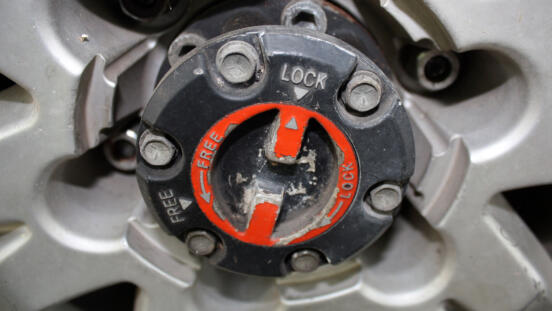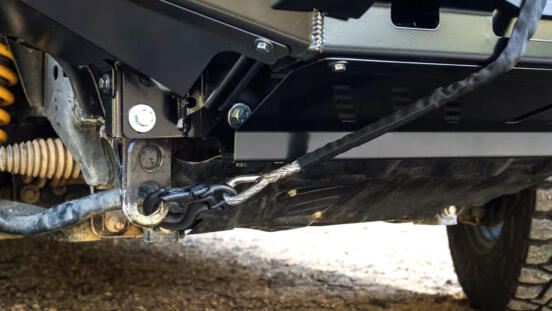
Yes. You do.
Any wheeler who has begun to dabble in adding 12v electrical devices to their vehicle – be it a fridge, inverter, power distribution box, etc. – will know the gist of how fuses work; something electrically “bad” happens, the fuse blows, sacrificing itself to break the connection from the battery, thereby protecting your fridge, inverter, or other device.
Mission accomplished, it would seem. It goes without saying that it’s better to destroy a $1 fuse than your $1,000 fridge or inverter.
It’s critical to understand though that fuses only provide protection after their location in the circuit. Just because a device has a fuse does not mean that its circuit is protected end-to-end.
The fuses in electrical devices such as fridges and inverters are built in to protect the devices themselves.
- They do not provide any protection for the battery.
- They do not provide any protection for the wiring.
- The fuse in your fridge in the boot of your wagon will not stop your vehicle from burning to the ground if a major short occurs in the cabin, surrounded by all that lovely flammable carpet and upholstery.
This last point is not being dramatic. It’s not a theoretical event for the sake of conversation. It happens.
Fuses at work
Let’s use a typical fridge setup in a four-wheel-drive wagon as an example.
- A battery sits in the engine bay.
- A twin-core cable (positive and negative wire) runs from the battery through the firewall, and into the cabin.
- The cable is run along the floor on the side of the vehicle, underneath the skirting, to the boot.
- The cable emerges into the boot and is typically connected to either a cigarette lighter socket or an Anderson plug.
- The fridge plugs into the socket or plug.
For the sake of example, let’s say our fridge has a 10 amp fuse. All the cabling from the battery to the fridge is in good condition and all connections are secure, the wiring is a sufficient gauge (size) for the power drawn by the fridge and its distance from the battery, and the insulation for all the wiring is intact.
A mischievous gremlin sends a surge of 20 amps through the circuit and the fridge’s fuse (the blue spark below) blows. With the circuit now broken, the flow of electricity stops, and the fridge, now unpowered, turns off.
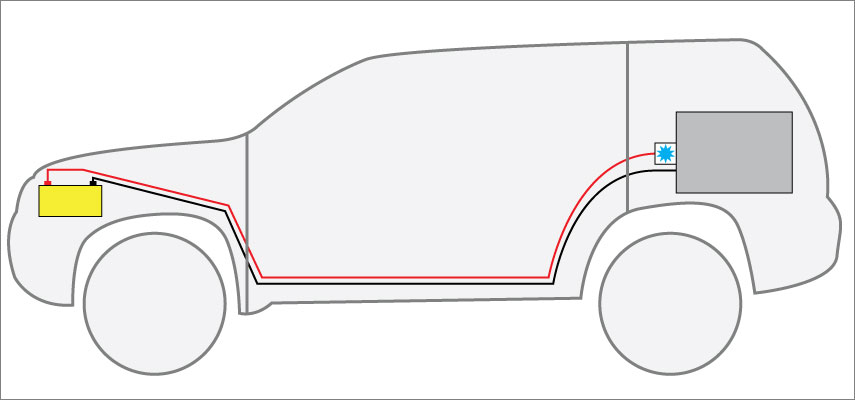
All you need to do now is replace the blown fuse in the fridge, and you’re back in business. In the case of a cabin located short-circuit though, the fridge’s fuse is not going to save your vehicle.
Where / how does a short-circuit occur?
Gremlins aside, a common real-world cause of electrical damage is a short-circuit due to the rubber insulation around wiring being worn away, caused by improper installation. A few examples of causes of this are:
- Cabling is run through metal holes in the engine bay firewall without rubber grommets for protection and is gradually cut through by the metal edge.
- Bare cable is run through the vehicle without protection such as split sleeve tubing, exposing it to rubbing.
- Cabling is left loose, or poorly secured, causing it to rub on the mounted surface as the vehicle moves around.
In a best-case scenario, a minor short of the positive cable will result in your battery draining while sitting idle at an accelerated rate. Where normally a vehicle with a healthy starter battery should be able to sit for a month and still start with no problem, a short can result in the same battery being drained overnight.
In a worst-case scenario, a major short – a positive cable is sheared, or connection comes completely free from a device allowing it to connect with something elsewhere in the vehicle while still being fully connected to the battery – can result in a huge amount of current being dumped into whatever the loose/frayed cable connects with; enough to melt metal and ignite anything flammable surrounding it.
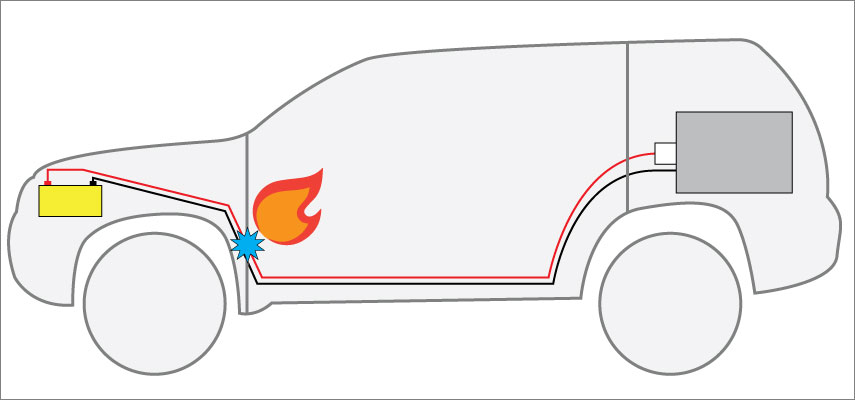
Why can short-circuits cause so much damage?
The issue is the amount of current a short-circuit can draw. If you’re unfamiliar with exactly what “current” means, think of it as the concentration of energy being transferred. Pretend you have 2 batteries sitting side by side, with an inverter running on each battery.
Battery 1 is connected to a 100-watt inverter. At 12 volts this inverter will draw roughly 8 amps of current when operating at full load.
Battery 2 is connected to a 200-watt inverter. At 12 volts this inverter will draw roughly 16 amps of current when operating at full load.
While both systems are 12 volts, twice the amount of current is flowing from battery 2.
This is key, as the amount of current drawn from a battery is dictated by the device, according to its needs. A few examples:
- A 5W UHF radio will draw somewhere around 2 amps while transmitting.
- A mid-size fridge will draw around 7 amps while the compressor is running.
- As above, a 200-watt inverter will draw roughly 16 amps of current when operating at full load.
- On the high end of the scale, a 2,000-watt inverter will draw roughly 166 amps at full load.
In the event of a major short, the battery will basically discharge current as fast as possible. Technically there are some limiting factors to this, e.g. the resistance of the wiring in the circuit, the battery chemistry, but in reality, this is largely academic and a moot point. A major short from a fully charged battery can easily generate amps in the high hundreds; as noted earlier, this is enough to melt metal and ignite anything flammable surrounding it.
If this happens inside your vehicle cabin behind the dash, or between the floor pan and upholstery, you can imagine what comes next.
Where to fuse your cables.
As noted earlier, fuses only provide protection after their location in the circuit. Because of this, fuses should be installed in your positive cable as close to the battery as is practically possible. See the example in blue below.
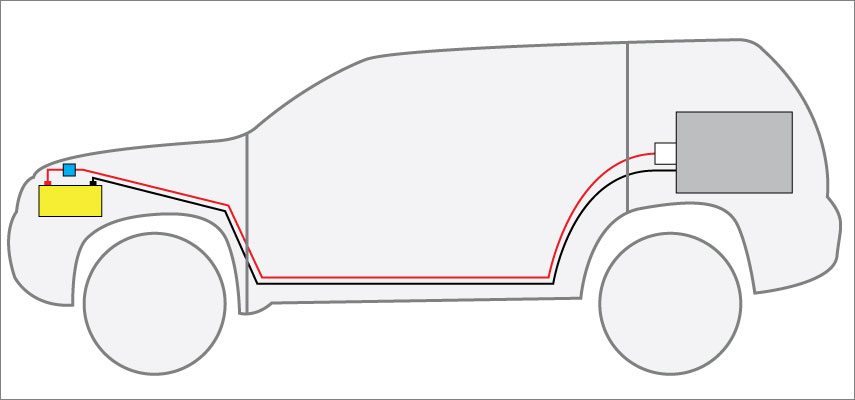
With the fuse installed ahead of the rest of the circuit, a short-circuit created anywhere throughout the cabin will be cut off safely from inside the engine bay when the fuse blows.
Additionally, do not install the fuse on the negative cable at your battery. By doing this you are adding protection to the end of the circuit, past the point where problems are going to occur, making it pointless.
With an appropriate fuse installed on the positive cable, immediately after the battery, you have protection in place for the entire circuit, from the firewall, into the cabin, and beyond.
Fuse your power cables, and potentially avoid a disaster.
# Auto electrical fuses, 12v electrical safety, 4WD 12v systems, 4WD off grid builds.



